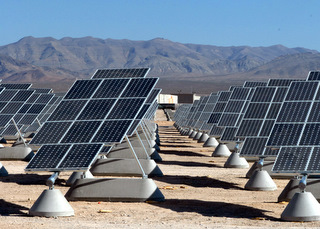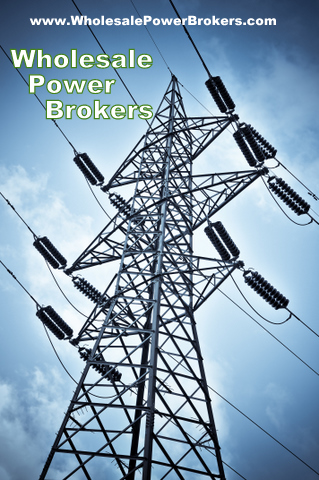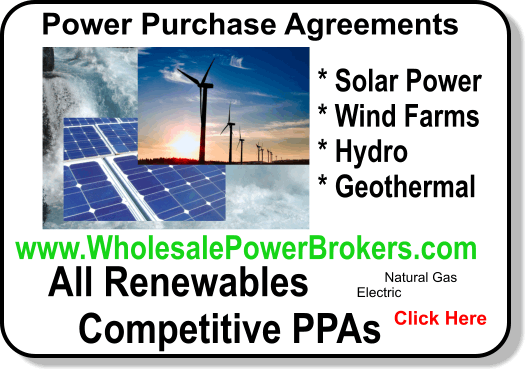Power Purchase Agreements (PPAs) for Solar energy, Wind power, Geothermal, Hydro, and other forms of renewable energy projects for natural gas, natural gas substitutes, and electricity generation.
PPAs for Medium to Large Capacity Projects (3 MW to 750 MW or more)
The PPAs we are referring to here are in the form of larger energy producing projects. For example, these PPAs go above and beyond the Net Metering type of projects for consumers and commercial corporations that are having installed PV solar panels on their roof tops to help provide part or even most of their energy needs, and are using a PPA as a financial vessel to fund and finance the solar project through a solar installation or solar panels manufacturing company.
Understanding Net Metering Power Purchase Agreements
Here is a quick overview of how Net Metering works. For example, since solar energy is produced during the day, and only when the sun is shinning on the photovoltaic panels, the project may produce more electricity than can be used by the company during the daylight hours, and through the use of smart meters, and feeding the excess power back to the grid, thus providing an energy credit that is then used up at night by the same company by drawing upon the electricity back from the local grid. If any excess energy is produced overall, there can also be other PPAs set up to sell the excess electricity to third parties, depending on a state’s public utility commission Net Metering laws. Many of these small project types of PPAs are getting quite creative in their written PPA terms, in ways of selling to other nearby companies (neighbors), for the excess generated electricity, and even how some of these renewable energy projects are financed through PPAs are quite ingenious, with sometimes very little upfront costs or no out of pocket expenses for the main electricity user/seller/owner and produce a significant utility bill savings at the same time.
Large Megawatt Capacity, Renewable Energy Projects PPAs
 The PPAs we are referring to here are written to account for excess power being sold to others, either in the case of various individual corporate projects with excess power being generated to be sold to others, or in the case of larger MW projects that are feed directly into the grid for the purpose of producing power to be sold in the market place through a PPA, with the intent to earn money for the renewable energy project ownership group.
The PPAs we are referring to here are written to account for excess power being sold to others, either in the case of various individual corporate projects with excess power being generated to be sold to others, or in the case of larger MW projects that are feed directly into the grid for the purpose of producing power to be sold in the market place through a PPA, with the intent to earn money for the renewable energy project ownership group.
So, let’s get down to it; you are looking for a power purchase agreement to get your renewable energy project off the drawing board, but not sure how to proceed. Financing may or may not be lined up yet, but at the heart of any renewable energy project, you need a power purchase agreement in place, before you can go forward. Project investors are going to want to know up front what their return on investment is going to be before putting 10 million or 950 million dollars on the line. Well, you’ve come to the right place. Wholesale Power Brokers can help get your energy producing project a very competitive rate with a very solid PPA, with an extremely financially stable and well established company willing to buy your generated electrical power and/or natural gas and natural gas substitutes from your renewable energy producing project.
Here is a general overview of a PPA for large renewable energy projects.
It’s not necessary to dive into to the minutia of a PPA here, but let’s take a general overview look from a utility company and other energy service providers’ perspectives. In general, we need to ask, what is a wholesale buyer of electricity looking for in the PPA they are willing to offer to an energy producer? The simple answer is: the buyer of the electricity wants to know how much electricity is going to be available at a given time of the day, on a given month of the year. They want to know how much is available to resell to end users. However, there is much more here than meets the eye.
Of course, the seller of electricity wants to get maximum dollar value for the renewable energy project and the electricity produced. Maybe your engineering department has determined using “ data that the proposed photovoltaic renewable energy project will produce an annual production total of “100X” MWhrs of power given the solar conditions and weather patterns for a solar project located in that sample area from the National Solar Radiation Data Base, and likewise a wind project data using the prevailing wind conditions at recommended height anemometer sample measurements over an entire year or more for a wind farm located at the proposed project location has predicted 200X MWhrs of total annual power being generated there. While these types of numbers certainly have merit for analyzing if a renewable energy project is viable or not, it does not properly address how the energy is to be sold in the marketplace.
Energy is sold by hour, by day, by month. Certain periods of the year have higher demands for energy than other periods. Likewise, energy demands are much higher during peak periods at certain times of the day and certain days of the week. Summer months, and mid day usage are typically the peak periods for electricity use. Hence there is a higher demand for those periods. All of this must be factored in to a PPA by the buyer of electricity.
What is the deal with electricity generation and electrical demand?
Electricity is typically a use it or lose it proposition. At this time, electricity can not be stored in a a large scale operation as with large batteries and pulled back in to the grid when required for peak periods. Yes, there are some very interesting technologies on the horizon that look promising in this area for battery storage on a large scale, but these are still in the small scale developmental phase and are not yet proven for the long haul. In essence, one has to think of the electrical grid as a supply and demand system. The grid system must be balanced for electric generation and electric usage. If too little electricity is being produced for the electricity demand, then brown outs and black outs could occur. If too much electricity is being produced for the electricity demand, then surges are likely to be produced. There is always a constant balancing act going on.
The problem with peak.
“While supply and demand is a bedrock concept in virtually all other industries, it is one with which the current grid struggles mightily because, as noted, electricity must be consumed the moment it’s generated.Without being able to ascertain demand precisely, at a given time, having the ‘right’ supply available to deal with every contingency is problematic at best. This is particularly true during episodes of peak demand, those times of greatest need for electricity during a particular period.1“
 While this is really not meant to be a primer on the national electrical grid, it is important to understand this from our sample PPA perspective. The importance of knowing, using forward looking data models, of what the anticipated supply is going to be from solar, wind, or any form of renewable energy can not be overstated. This is why the source data for a PPA must have the supporting documentation in place, and in addition, must be quickly viewable by 24 hour periods for all 12 months of the year. This is true not only for the seller of the power, but especially true for the buyer of the power. In essence, the seller should try to estimate as close as possible for time of day, and month of the year what the electricity production will be. If you as the seller understate your electricity generation estimate, then you will be leaving money on the table. If you as the seller overstate your estimate for electricity generation, many PPAs have minimum production quotas for specific times of the day for specific months of the year. In essence, the PPA will end up penalizing the project quite substantially for under-performance when your renewable energy project goes into production. Thus, you will not be making the money you expected to be making for your investors and shareholders. That would not be a very good picture indeed.
While this is really not meant to be a primer on the national electrical grid, it is important to understand this from our sample PPA perspective. The importance of knowing, using forward looking data models, of what the anticipated supply is going to be from solar, wind, or any form of renewable energy can not be overstated. This is why the source data for a PPA must have the supporting documentation in place, and in addition, must be quickly viewable by 24 hour periods for all 12 months of the year. This is true not only for the seller of the power, but especially true for the buyer of the power. In essence, the seller should try to estimate as close as possible for time of day, and month of the year what the electricity production will be. If you as the seller understate your electricity generation estimate, then you will be leaving money on the table. If you as the seller overstate your estimate for electricity generation, many PPAs have minimum production quotas for specific times of the day for specific months of the year. In essence, the PPA will end up penalizing the project quite substantially for under-performance when your renewable energy project goes into production. Thus, you will not be making the money you expected to be making for your investors and shareholders. That would not be a very good picture indeed.
The bottom line for power purchase agreements from the seller’s perspective, is it pays to be right, and be right on as much as possible. Your return on investment depends on it.
Wholesale Power Brokers is your “right on” source for getting you the best PPA deal for your project. Contact Wholesale Power Brokers today.
Oh by the way, if you are looking for financing for your renewable energy project, or are looking to sell your Solar Renewable Energy Certificates or Solar Renewable Energy Credits (SRECs), or other forms of Renewable Energy Credits (RECs) and get a commitment from a buyer for future REC purchases, Wholesale Power Brokers is in an excellent position to help you with both the financing and selling of the REC credits to maximize your returns.
Resources:
1. The Smart Grid: An Introduction, DOE, www.energy.gov, Department of Energy – Smart Grid

